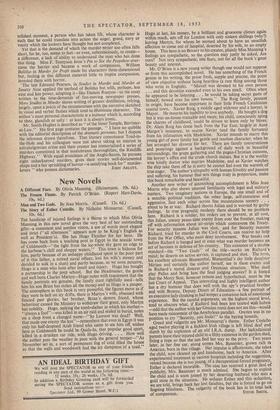Murder a la Carte
A READING public for crime reports is one of the few constant factors upon which the publisher may rely, with the proviso that murder is always far more acceptable to that public than any other crime. Style has changed more during the past hundred years in this class of writing than in almost any other. Pierce Egan—one of the most popular of all reporters—could write (Trial of Thurtell and Hunt, 1824) " And this deponent saith, that Upson then said, ' Hunt, you have a mother ? ' Deponent answered Yes, he had.' And a wife also ? ' Deponent told him he had. He then asked, Do you love them ? ' Deponent replied Yes, very dearly.' Then,' said he, for their sakes, do not risk suffering a terrible death, but give
your evidence immediately.' Those conversant with Judge's Rules may be surprised.
In the same year The Murder of Weare contained the less precise but more vivid passage " After John Thurtell arrived, I walked with him in the garden, and he asked me if the body rose ? I said no • it would lie there a month." The speaker was " liberated."
The story was then told in terms of evidence which, to those whose business it is, has weight but, in the last analysis, no character. The true demand of the readers of reports of murder is character. Their hunger is that which draws huge crowds to watch a murderer ushered from a car to the court—to see, m the flesh, for a bfief but long- relished moment, a person who has taken life, whose character is such that he could translate into action the anger, greed, envy or vanity which the lookers have thought but not completed.
Yet that is the demand of which the murder writer too often falls short, for he, too, seems to feel—or even, subconsciously, to create— a difference, a lack of ability to understand the man who has done this thing. Miss F. Tennyson Jesse's Pin to See the Peepshow over- came the barrier and became a work of compassion. William Bolitho in Murder for Profit made his characters three-dimensional but, finding in this different material little to inspire compassion, invested them with horror.
' The late Edmund Pearson, in Studies in Murder and Murder at Smutty Nose applied the method of Bolitho but with, perhaps, less ease and less power, adapting it—like Damon Runyon—to the essay written to the time-demands of fast-moving newspaper presses. More Studies in Murder shows writing of greater distillation, relying, largely, upon a précis of the circumstances with the narrative sketched in visual and verbal flashes which tend to illuminate character. The author's most personal characteristic is a humour which is, according to taste, ghoulish or salty : at least it is always ironic. Mr. Smith-Hughes is described as " of the Inner Temple, Barrister- at-Law." His first page contains the passage, ".I have no quibble with the editorial description of the dramatis personae, but I dispute the inference drawn therefrom. That literary connoisseur Toad-in- the-Hole and his colleagues were not above taking an interest in extrabelgravian crime and their creator has immortalised a series of murders committed in that insalubrious thoroughfare, the Ratcliffe Highway." With equal avoidance of the Anglo-Saxon, he pursues eight unhackneyed murders, gives their stories well-documented shape and a fair sprinkling of horror—a satisfying book for" murder- lovers " who possess dictionaries. JOHN ARLOTT.



































 Previous page
Previous page